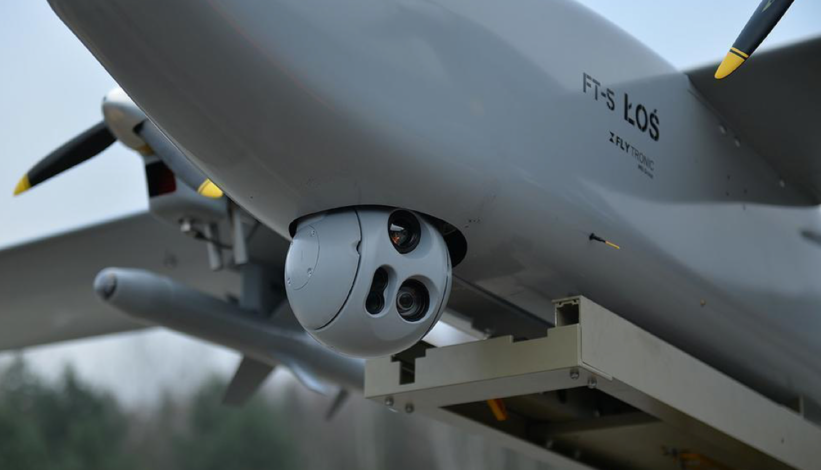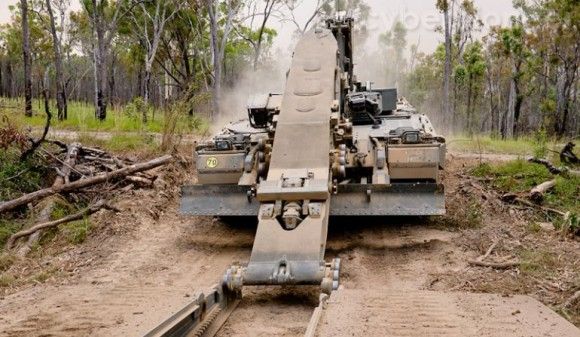Armed Forces
Łoś – Polish UCAV [Defence24.pl TV]
FT-5 Łoś (Eng. Moose) UAV has been developed by Flytronic, in collaboration with the WB Group. The drone has been designed with the “Orlik” tactical short range UAV programme in mind. It is also offered to the foreign customers. The design in question belongs to the family of the remotely piloted aircraft developed by the WB Group. Not only may Łoś be utilized as a reconnaissance platform, as it also acts as a carrier which is tasked with delivering the ordnance, including the loitering munitions, onto the battlefield.
Flytronic company based in Gliwice, belonging to the WB Group, has prepared a number of short range UAV systems that could potentially be submitted as an offer within the “Orlik” tactical UAV procurement programme. Manta system is, within that category, the most innovative model, utilizing a flying wing design in two versions – conventional and VTOL one. The UAV in question has a hybrid propulsion system and high lift-to-drag ratio, which translates into good performance.
FlySAR UAV, on the other hand, takes a shape which is much more conventional. It is a research platform, featuring a Synthetic Aperture Radar within its structure. FlySAR is a conventional monoplane with pulling propeller and an internal combustion engine, providing the user with a performance allowing the operator to carry out a patrol sortie along the whole length of the Polish coast, both ways.
On the other hand, FT-5 Łoś platform premiered during the MSPO 2016 event in Kielce, is the third proposal which may potentially be offered in the “Orlik” programme. FT-5 UAV is characterized by armament carrying capacity, even if this is not an official requirement, defined within the short range tactical UAV tender pursued by the Polish Army.
Twin-Engined Łoś – An Atypical Solution
Despite its conventional monoplane design with T-shaped empennage, FT-5 Łoś UAV is not similar to any of the most common conceptual design solutions that are currently remaining in existence within its class. It is a twin-engined system, powered by pull propellers. The name, and the design, may form associations with the pre-war Łoś bomber.
The UAV system developed by Flytronic makes use of an internal-combustion propulsion which, as mentioned by the representatives of the manufacturer, simplifies the design and prolongs the flight endurance. Moreover, the fact that Łoś uses two engines also renders the system more resistant to damage that may be related to the propulsion system. Similarly, as in a conventional multi-engined aircraft, Łoś has power reserves at its disposal, that make it possible for the UAV to remain airborne flying on a single engine.
Two engines also generate much more electricity, when compared to a single propulsion unit, which is quite important when it comes to provision of power supply for the onboard optronic systems and any extra payload that may be needed.
In case of the UAV system of this class, the power reserves may be translated into an ability to simultaneously provide power to several types of payload, including synthetic aperture radars, optronic suites, or signal transmitters and retransmitters of higher power. This, on the other hand, expands the functionality of the UAV.
Multi-Purpose Reconnaissance and Combat Tool
FT-5 Łoś may be operated both by the Armed Forces, as well by other uniformed services, rescue services or companies and organizations. Up to 30 kilograms of usable payload may be carried by the said UAV.
Łoś, in its standard configuration, is being fitted with a retractable optronic sensor, hid within the fuselage during take-off and landing. FT-5 may also be fitted with extra sensors, as well as embedded and underslung systems.

Among those systems, one may find the ELINT and COMINT suites, SAR radar system, contamination sensors, signal transmitters and many other elements that may turn out to be quite usable during the reconnaissance sorties. The onboard datalink is fully redundant, and, as the representatives of the WB Electronics company assure, the system makes it possible to integrate extra components, expanding the situational awareness of the UAV operators, thanks to a data fusion. In practical terms, this means that data downloaded from a variety of sensors and systems may be translated into an encoded transmission, received by the operator and further recipients.
30 kilograms of usable payload allow Łoś to become a UCAV, capable of carrying guided armament. Here, WB Electronics offers its Sting gliding bombs, however other options are not being ruled out. During a display organized for the Polish Defence Minister, Antoni Macierewicz, at the Zielonka range, FT-5 Łoś UAV was carrying two Larus guided bomb units developed by the Military Institute of Armament Technology.
When loitering munitions are used, not only could Łoś become a carrier, as thanks to retransmission of the signal, it may also extend the range at which the drone remains controllable, also in case of the e.g. Warmate system, providing the user with beyond-the-horizon connectivity between the ground-based transmission units.
High Performance Airframe
Łoś UAV is 3.1meters long, its wingspan is 6.4 meters, while maximum take-off weight is defined as 85 kilograms. The UAV attains top speed of up to 180 kilometres per hour, taking off from a towed launcher, within which the operator’s station has been placed, along with the communications and control suite. The direct radio communication may be maintained between the UAV and the operator at distances of up to 180 kilometres.
The design solutions adopted in case of the airframe of the UAV, in this class, make it possible to tailor the payload to the user-defined needs. The navigation suite utilizes the GPS, but should the signal be unavailable or jammed, Łoś still retains ability to continue its flight with the use of the INS system or elevation data. This is to expand the options of continuing the combat sortie, should the enemy be in possession of countermeasures, or when the drone is operated in an EW-saturated environment.

The flight endurance depends on the weight of the carried payload which takes on a form of reconnaissance systems or armament. The maximum flight endurance is 18 hours, but in standard configuration and weather conditions, the user may expect of the UAV to be operable for at least 12 hours.
Runway is not required for the FT-5 to land, as it is designed to perform landing “in the wild” or on special purpose braking mats, due to relatively low stall speed, compact design and ability to retract the optronic sensors and protect them inside the fuselage. Both the take-off, as well as landing may be automatic, which makes it easier for the operator to control the UAV and minimizes the potential impact human factor may have on damaging the drone.
Potential Users
Polish Defence Minister, Antoni Macierewicz, expressed his interest in the FT-5 Łoś UAV system, stating that the Polish Army shall take advantage of a wide array of UAV systems manufactured domestically – “We hope that they will soon enter series production.Starting from the largest Łoś UAV, which is to have combat capability thanks to the underslung ordnance, finishing with the smallest UAVs which are to be operated in the urban areas.The operational capabilities are huge. ” – as it was stated by Antoni Macierewicz, during the display of the Łoś system.
Łoś is also the largest of the UAV systems offered by WB Group. It becomes a subject of numerous requests for information submitted by the foreign customers. Similarly to the smaller designs that are already being exported – Warmate or FlyEye – Łoś UAV has also been showcased abroad. At the beginning of December 2016, the UAV was showcased in flight and within a static display in front of the Secretary of the Ukrainian National Security and Defence Council, Olexandr Turchynov. Ukraine is currently interested in this type of technology, due to the intense UAV operations carried out during the fights against the “separatists” in Donbas. Kiev has already received a batch of the FlyEye systems, which are the smaller UAV platform, also designed by the WB Group. Moreover, other stations have also expressed their interest in the “Łoś” system, which could have been witnessed e.g. during this year’s MSPO event.





